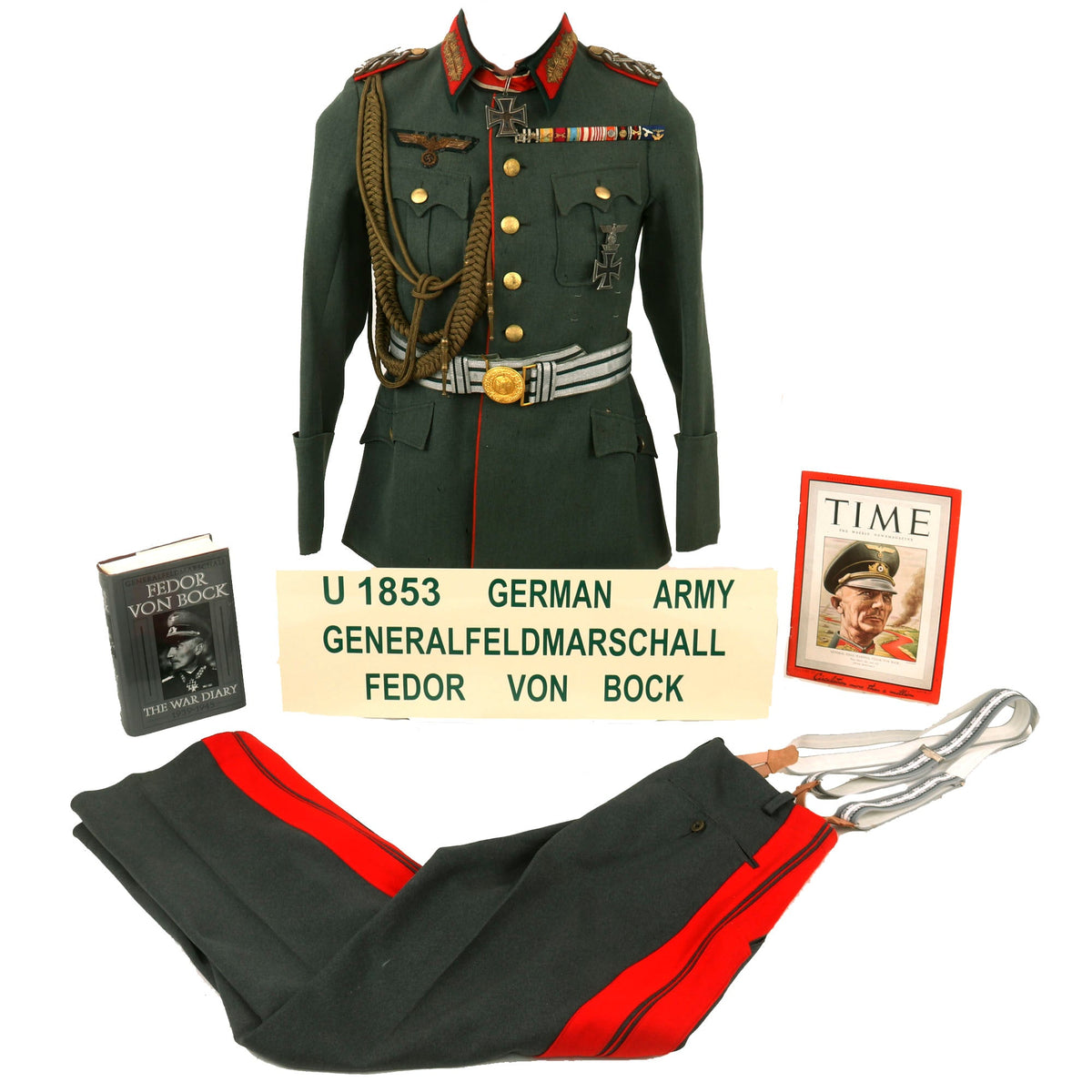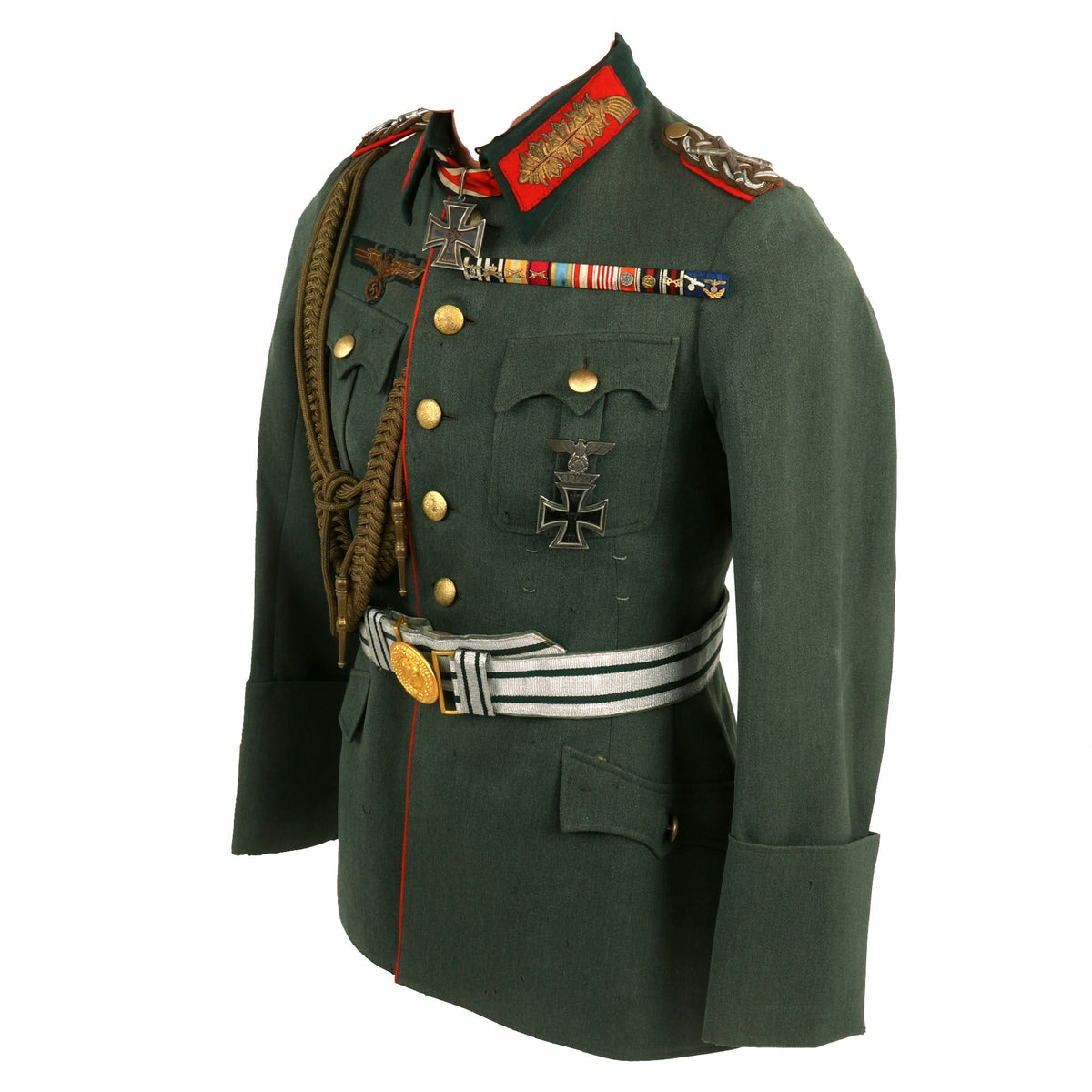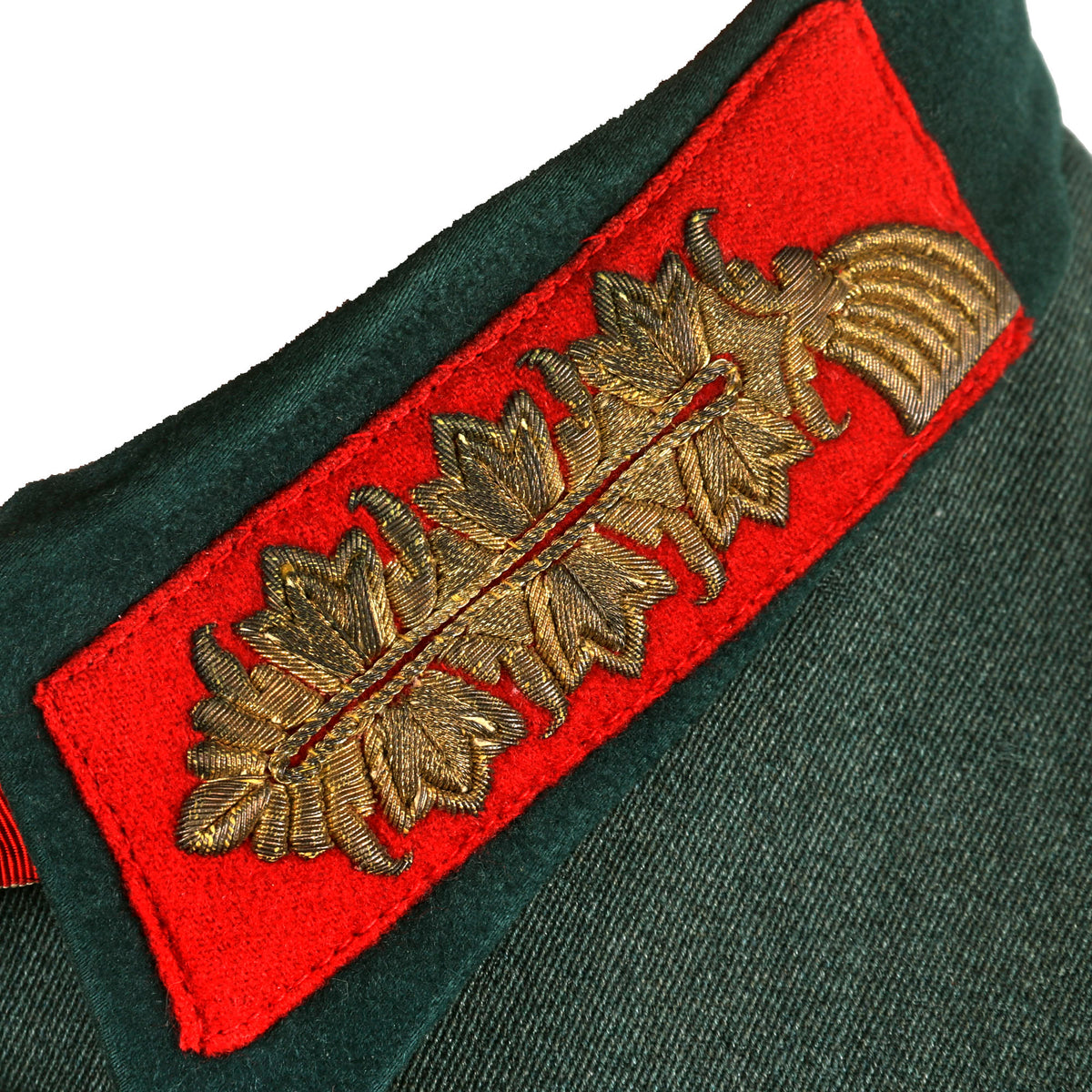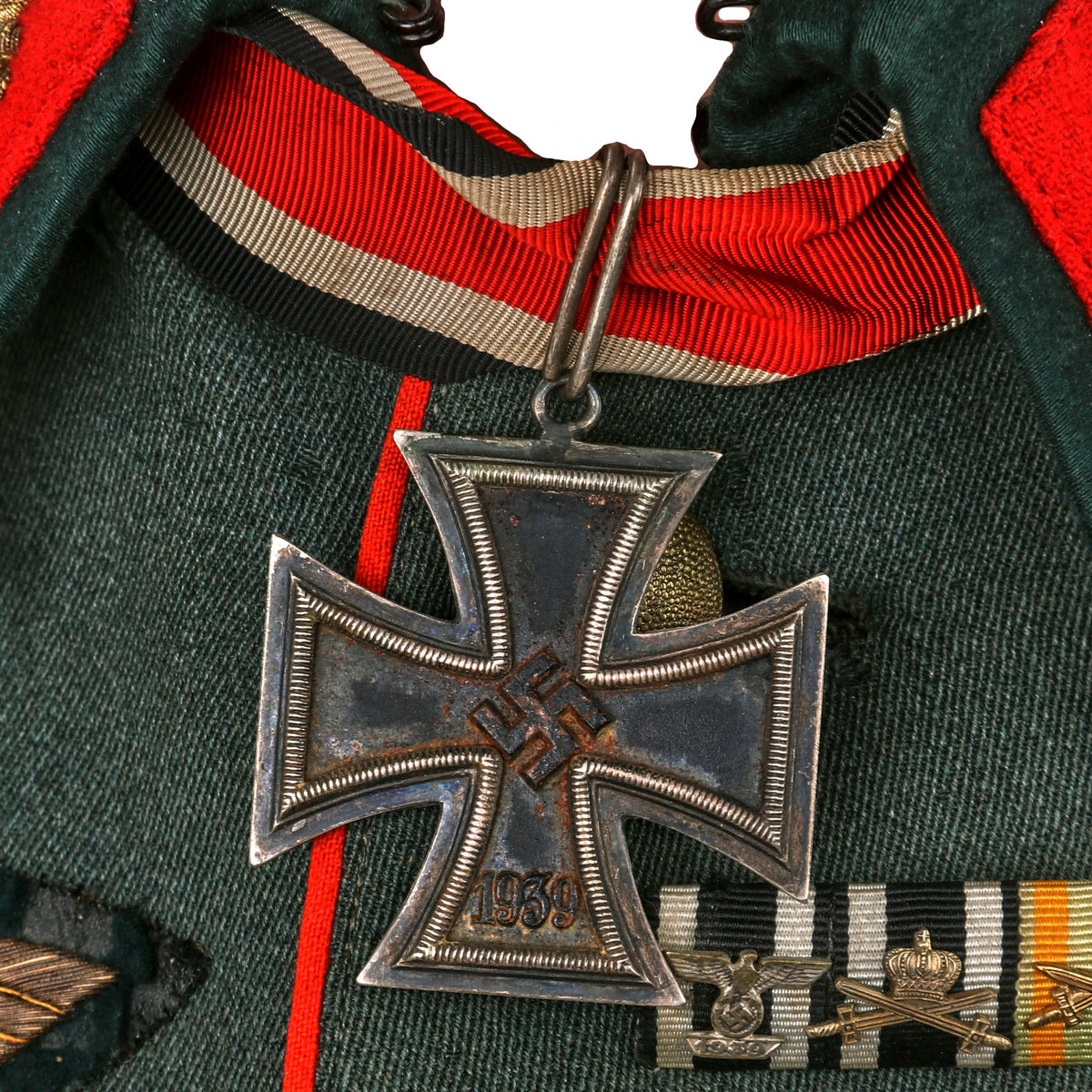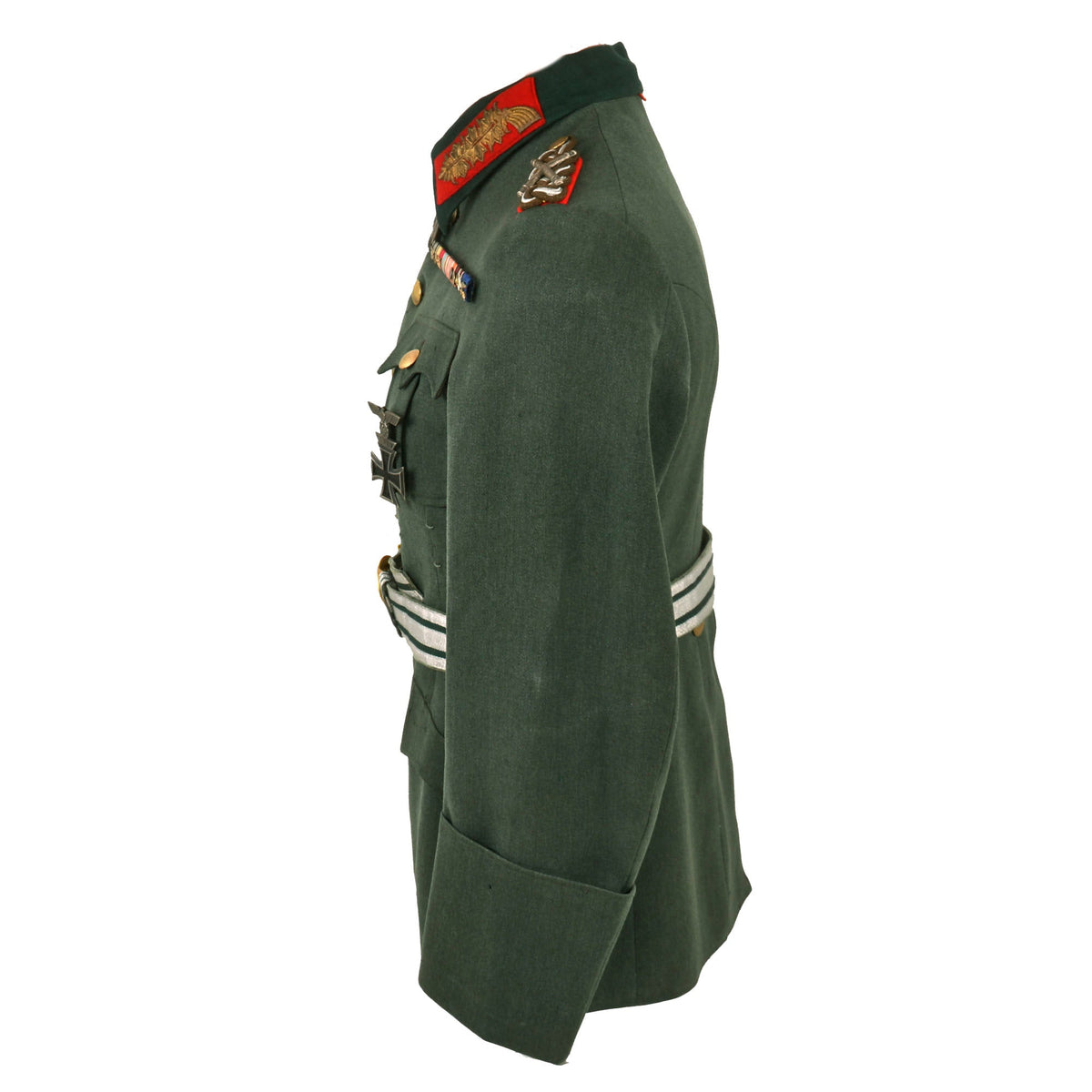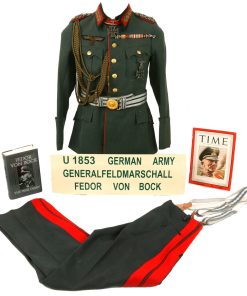Original German WWII Heer Army Group Commander Generalfeldmarschall Fedor von Bock Uniform & Research Set – Formerly Part of the A.A.F. Tank Museum Original Items
$ 19.995,00 $ 4.998,75
Original Items: One-of-a-kind set. Moritz Albrecht Franz Friedrich Fedor von Bock (3 December 1880 – 4 May 1945) was a German Generalfeldmarschall (Field Marshal) who served in the German Army during the Second World War. Bock served as the commander of Army Group North during the Invasion of Poland in 1939, commander of Army Group B during the Invasion of France in 1940, and later as the commander of Army Group Center during the attack on the Soviet Union in 1941; his final command was that of Army Group South, which he held 12 January 1942 to 9 July 1942.
Unfortunately, German Führer Adolf H became displeased with Bock’s plan to delay a Stalingrad offensive in order to eliminate forces on the Voronezh Front under Nikolai Vatutin, and relieved him of command. Bock would never hold a senior command position again, a pattern observed throughout the war with Top German Military Commanders who displeased Der Führer. He lived in virtual retirement until 3 May 1945, when his car was strafed by a Hawker Tempest from No. 486 Squadron RNZAF killing his wife, stepdaughter, and a friend. Initially the only survivor of the attack, Bock died of his injuries the following day. He was buried in a cemetery in Lensahn.
This wonderful German WWII Uniform & Research Set came to us from the American Armoured Foundation, Inc. Tank and Ordnance Memorial Museum. The AAF Tank Museum was a living memorial dedicated to the Tank and Cavalry soldiers of the world. Before 1981 some of the artifacts that make up the AAF Tank Museum was a private collection belonging to Mr. William Gasser. Mr. Gasser felt that his collection would be beneficial in educating present and future generations to the sacrifices made and the technologies gained during war. Therefore, in 1981 the AAF Tank Museum was established as a non-profit charitable organization, and Mr. Gasser’s donated his private collection to the Tank Museum. Mr. Gasser is still active as Volunteer Director and Curator of the Tank Museum and his knowledge of military history has been a great asset to the museum. Unfortunately after 20 years of operation it had to close its doors, which is when this set was acquired.
Born 3 December 1880 into an old Prussian military family, Fedor von Bock attended a military academy in Berlin from the age of 8, eventually graduating and joining the military. He was well known for his unquestioning loyalty to the state and dedication to the military profession. In 1908, Bock entered the War Academy in Berlin, and after a year’s study he joined the ranks of the General Staff, and by the onset of WWI had reached the rank of Captain. He served as a battalion commander in January and February 1916, and by 1918 had reached the rank of major. He was decorated with Pour le Mérite, the German Empire’s highest military decoration.
Following Germany’s defeat, he continued his service as a member of the Reichswehr under the Weimar republic, and rose steadily through the ranks. He had been a member of a group tasked with helping plan a way for Germany to evade post war restrictions, and continued his service after the NSDAP takeover of Germany. He was already a high ranking General officer by that point, and was promoted to Generalfeldmarschall in 1940 for his part in Germany’s victorious blitzkrieg campaign against France and the Low Countries.
He was well-decorated, and the following are just the highlights of his many decorations:
● Iron Cross (1914)
– 2nd Class
– 1st Class
● Cross of Honor for Frontline Fighters
● Pour le Mérite
● Iron Cross (1939)
– 2nd Class (spange)
– 1st Class (spange)
Most notably, he was awarded the Knight’s Cross of the Iron Cross on 30 September 1939 for his participation during Operation Fall Weiss during the Polish campaign. Bock was credited with being a great leader during this time, driving around 6000 km during the first days of the combat in order to ensure that every opportunity was being utilized. He made particular care to ensure that the artillery and heavy weapons were always in a position to support the infantry’s swift advance.
It should also be noted that due to his long service he would have qualified for the Wehrmacht Long Service awards, and many other awards not listed. The Traces of War website gives a great listing of his various awards and when they were received. Many of these are represented in the MASSIVE medal bar his uniform bears, and it still has a great Iron Cross 1914 1st Class with a 1939 1st Class Spange attached to the top. Also included is a “Field Upgraded” Knights Cross of the Iron Cross, made from a 1939 Iron Cross 2nd Class, upgraded with a hanger loop and original ribbon.
During his service in the Wehrmacht during WWII, von Bock held the following commands, all of which would have included Panzer Divisions, so it is not hard to see why his uniform was in the collection of the museum:
● Gruppenkommando 1 (1938),
● Army Group North (August 1939)
● Army Group B (October 1939)
● Army Group Center (October 1941)
● Army Group South (January 1942)
The uniform in this set could be from any time after he was promoted to Generalfeldmarschall in 1940, and unfortunately there are no tags to give any dates, so we are not able to provide any concrete date. It has an embroidered letter B tag by the internal pocket for his last name, with no other tags present, though there may have been additional tags in the past. The tunic is really a great example of a private purchased Wehrmacht Heer Dienstbluse. It is constructed from a fine quality field-gray wool “whipcord” woven exterior, with a silk-rayon blended interior lining.
The collar is covered with flaschengrün (dark bottle-green) wool, and is adorned by a set of post 1941 Field Marshall grade collar tabs, known as alt-Larisch or Arabesque style, which feature the correct gold bullion embroidery on red backgrounds. These are very similar to those worn by General grade officers, except there are 3 of the dual leaf devices for Field Marshalls, compared to 2 for generals. Prior to 1941 they had used the same collar tabs for all General grade officers. The right chest is adorned with the correct gold bullion embroidered Wehrmachtadler eagle, which has celleon retaining threads. It is neatly stitched to the uniform in a fashion typical of wartime tailor work.
Each shoulder is decorated with the sew-on style Generalfeldmarschall rank shoulder boards. They are both constructed out of a row of interwoven silver and gold bullion strands in the typical Russian braid style in an interlocking weave pattern ending at a pebbled gilt metal (magnetic) button. This is the Pre 1941 pattern, which was later changed to be all gold. They have the crossed batons insignia of a Field Marshall attached on top of the braids. The right shoulder also has a great set of gold bullion General officer’s dress aiguillette cords installed. Additional decorations include a lovely VERY long medal bar, a WWI 1914 Iron Cross 1st Class with a WWII 1939 Clasp above it, and the Field upgraded Knight’s Cross.
Included with the uniform is a great totally correct General Officer’s brocade belt, outfitted with the correct gold washed buckle and end clasp. It is in excellent condition, and the rear of the buckle has a “Barred A” marking on the clip, the trademark of F. W. Assmann & Söhne of Lüdenscheid, a well-known manufacturer of buckles and other clothing accoutrements.
Finishing out the uniform is a lovely set of Generals trousers in the correct stone gray (steingrau) color, with red stripes on the side, which come with the correct suspenders. They are in very good shape, and definitely period correct, though they do not have any markings on the inside. The jacket, belt, and pants are all for a very slim individual, which period photographs confirm would be correct for a uniform worn by Fedor von Bock.
Along with the uniform are some great additional items that really flesh out this fantastic set, and add lots of wonderful research and display potential. These include:
● The original painted metal display placard used when the uniform was owned and displayed by the A.A.F. Tank Museum.
● A copy of Generalfeldmarschall Fedor von Bock: The War Diary 1939-1945, taken from von Bocks memoirs and edited by Klaus Gerbert, later translated to English by David Johnston. 1996 Edition with ISBN: 0-7643-0075-X. This looks to have been consulted and had some notations added about von Bock, including that he was a very slim individual, narrow at the shoulder, and stood ramrod straight, matching the uniform. There are numerous pictures in the book showing von Bock with the top brass of NSDAP Germany.
● A TIME magazine dated SEPTEMBER 21, 1942 with a portrait of GENERAL FIELD MARSHALL FEDOR VON BOCK on the cover. This is stamped with HENDERSON PUBLIC LIBRARY, and we assume it is original, acquired after the library most likely transferred their holdings to microfiche or digital. Pages 21-24 show a caricature cartoon of von Bock shoveling more soldiers into furnace, followed by a short article on the Eastern Front.
● Several photocopies from the book H***er’s Generals and their Battles by Shelford Bidwell, which gives details on von Bock and the Eastern Front.
● Numerous photocopies from two different books, showing battle formations during what looks to be the Eastern front campaign commanded by von Bock.
We very seldom get uniform sets with such great display and research potential. This could become the centerpiece of your WWII collection. Ready to research and display!
More on Generalfeldmarschall Fedor von Bock
Bock commanded Operation Typhoon, the ultimately failed attempt to capture Moscow during the autumn and winter of 1941. The Wehrmacht offensive was slowed by stiff Soviet resistance around Mozhaisk, and also by the rasputitsa, the season of rain and mud in Central Russia. The Soviet counteroffensive soon drove the German army into retreat, and Bock was subsequently relieved of command by Adolf H***er, along with many other commanders. He would later return to command during 1942’s summer offensive, before being removed from command by der Führer again.
A monarchist, Bock was not heavily involved in politics and he did not sympathize with plots to overthrow Adolf H***er. Bock was also uncommonly outspoken, a privilege H***er extended to him only because he had been successful in battle. After Germany escalated the campaign in Russia to a war of annihilation, widespread atrocities were committed against Soviet civilians by Reinhard Heydrich’s Einzatsgruppen units. This outraged many of Bock’s subordinate officers, including Army Group Center Chief of Staff and Valkyrie plan conspirator Colonel Henning von Tresckow. Bock privately expressed outrage at the atrocities, but is unwilling to take the matter directly to der Führer. Instead, he sent one of his subordinate officers to lodge the complaint. When his envoy returned empty-handed, Bock declared triumphantly, “Gentlemen! Let it be noted that Field Marshal von Bock protested.” Once he failed to achieve success, he was out of the good graces, and was placed into semi-retirement.
In 1944, Bock was approached by his nephew Henning von Tresckow about the possibility of joining the July Plot. Bock refused, but did not pass details onto the Gestapo. After der Führer’s suicide, Bock offered his services to the interim Doenitz government, but Bock, his second wife and his stepdaughter were killed by a strafing Royal New Zealand Air Force fighter-bomber on 4 May 1945, during an Allied air raid on Hamburg. This was only a few days prior to the German surrender.
Fast Shipping with Professional Packaging
Thanks to our longstanding association with UPS FedEx DHL, and other major international carriers, we are able to provide a range of shipping options. Our warehouse staff is expertly trained and will wrap your products according to our exact and precise specifications. Prior to shipping, your goods will be thoroughly examined and securely secured. We ship to thousands clients each day across multiple countries. This shows how we're dedicated to be the largest retailer on the internet. Warehouses and distribution centres can be located throughout Europe as well as the USA.
Note: Orders with more than one item will be assigned a processing date depending on the item.
Before shipping before shipping, we'll conduct a thorough inspection of the items you have ordered. Today, the majority of orders will be delivered within 48 hours. The delivery time will be between 3-7 days.
Returns
The stock is dynamic and we cannot completely manage it because multiple stakeholders are involved, including our factory and warehouse. So the actual stock may alter at any time. It's possible that you may not receive your order once the order has been made.
Our policy is valid for a period of 30 days. If you don't receive the product within 30 days, we are not able to issue a refund or an exchange.
You can only return an item if it is unused and in the same state as the day you received it. You must have the item in its original packaging.
Related products
Uncategorized
Uncategorized
Uncategorized
Uncategorized
Uncategorized
Uncategorized
Uncategorized
Uncategorized
Uncategorized
Uncategorized
Uncategorized
Australian WWII Owen MK1 Machine Carbine SMG Custom Fabricated Replica with Sling Original Items
Uncategorized
Uncategorized
Uncategorized
Uncategorized
Uncategorized
Uncategorized
Uncategorized
Uncategorized
Armoured Fighting Vehicles of the World: AFVs of World War One (Hardcover Book) New Made Items
